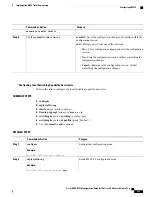
Before you can successfully bring optical TE tunnels
“
up,
”
you must complete the procedures in the
preceding sections.
Note
The following characteristics can apply to the headend (or, signaling) router:
•
Tunnels can be numbered or unnumbered.
•
Tunnels can be dynamic or explicit.
The following characteristics can apply to the tailend (or, passive) router:
•
Tunnels can be numbered or unnumbered.
•
Tunnels must use the explicit path-option.
Configuring an Optical TE Tunnel Using Dynamic Path Option
Perform this task to configure a numbered or unnumbered optical tunnel on a router; in this example, the
dynamic path option on the headend router. The dynamic option does not require that you specify the different
hops to be taken along the way. The hops are calculated automatically.
The examples describe how to configure optical tunnels. It does not include procedures for every option
available on the headend and tailend routers.
Note
SUMMARY STEPS
1.
configure
2.
interface tunnel-gte tunnel-id
3.
ipv4 address ip-address/prefix
or
ipv4 unnumbered type interface-path-id
4.
switching transit switching type encoding encoding type
5.
priority setup-priority hold-priority
6.
signalled-bandwidth
{
bandwidth
[
class-type ct
] |
sub-pool bandwidth
}
7.
destination ip-address
8.
path-option path-id dynamic
9.
direction
[
bidirectional
]
10.
Use the
commit
or
end
command.
DETAILED STEPS
Purpose
Command or Action
Enters global configuration mode.
configure
Example:
RP/0/RP0/CPU0:router# configure
Step 1
Cisco IOS XR MPLS Configuration Guide for the Cisco CRS Router, Release 5.1.x
259
Implementing MPLS Traffic Engineering
Configuring GMPLS






























